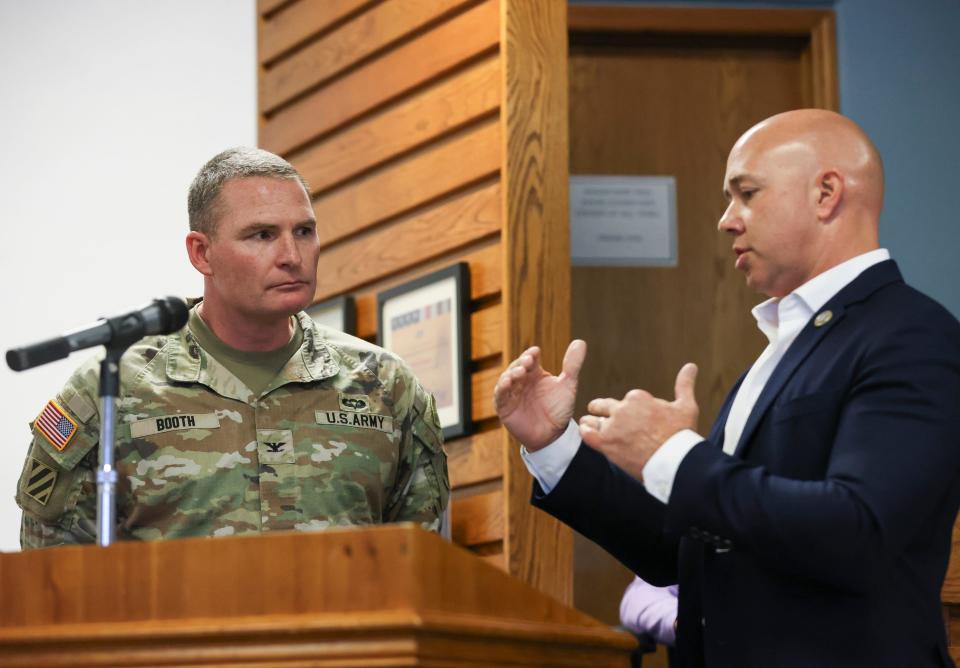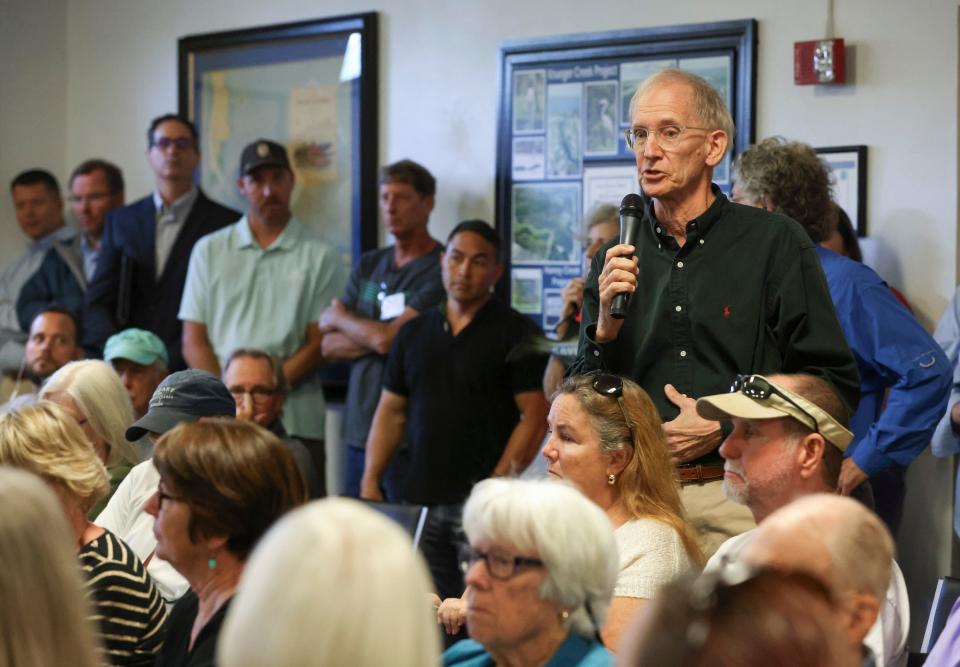Treasure Coast residents rail against Lake Okeechobee discharges at Rivers Coalition
Treasure Coast residents railed against Lake Okeechobee discharges to the St. Lucie River in Stuart Thursday during the River Coalition’s monthly meeting.
The Stuart City Commission meeting chambers was so packed, people spilled out into the hallway. The audience was angry and raucous, often applauding and yelling out responses and questions.
Discharges, which began Feb. 17 and are expected to end April 1, will release about 12 billion gallons of polluted lake water into the river for 10 days. The Army Corps of Engineers has not answered TCPalm's detailed questions about the release schedule.
What are Lake Okeechobee discharges? Risks include water pollution and toxic algae blooms

The Army Corps is prioritizing Lake O’s health and “flood risk management” for residents who live around the lake, Col. James Booth said. Models show the releases could lower the lake level to 14.5 feet in time for the June 1 start of hurricane season, which is still 2 feet above the historic goal.
“We acknowledge this isn’t good enough,” Booth said to the crowd. “Today, we are having environmental impacts here on St. Lucie estuary. I do apologize for that.”
Residents are demanding zero discharges and more lake water sent south to the thirsty Everglades as nature intended. Residents carried signs reading, “NO MORE DISCHARGES,” which the nonprofit Friends of the Everglades distributed before the meeting. Rebecca Fatzinger of Rio carried a wooden cutout of a snook bearing the words, "Save our River.” Another wore a shirt saying, “Ask me about algae.”

Zero discharges may be closer to reality when the Army Corps puts its new lake level management policies into full effect, expected to be “sometime this year.” The new Lake Okeechobee System Operating Manual (LOSOM) being developed will replace the current 2008 Lake Okeechobee Regulation Schedule (LORS) and is projected to curb Lake O discharges by 37%.
Inshore fishing guides, scientists, a diver and residents said they've already seen the effects of the most recent discharges: stirred silt and murky water, muddy as chocolate milk, sailboats moored at Sunset Bay Marina swung southward in the current and lower salinity in the river, which damages and kills oysters and seagrass.
Diver Russell Singson captures videos of boats for customers, but he said he can’t see his outstretched hands under the St. Lucie River water. His team can’t work this week. Divers have gotten sick from working in Lake O water in the past, he said.
“It's obvious to me because we work from Fort Pierce to Fort Lauderdale. Palm Beach has blue water, Fort Pierce has blue water and this area is so black, and I'm like, ‘This is ridiculous,' ” Singson said.

Former Stuart Mayor Merritt Matheson asked if homes and residents are prioritized with flood risk management.
“In times like now, our estuaries are being flooded,” Matheson said. “It impacts our health, our businesses. For years, Stuart and the people in this room felt that there's one entity that doesn't share diversity or doesn't get flooded. And it's land on the Everglades Agricultural Area (EAA).”
South Florida Water Management District Executive Director Drew Bartlett said the SFWMD is sending water south. District data shows that may be true, but certainly not at a rate that's comparable to those being sent east and west. It shows zero water moving south through the Miami Canal (S-354) on Feb. 19 and 20; Zero water moving south through the New River Canal (S-351) Feb. 17 through Feb. 20; About 40 million gallons per day through the West Palm Beach Canal to the Lake Worth Lagoon (S-352) and an average of 43 million gallons per day out of the S-271 canal near Sand Cut which has no name, according to a SFWMD spokesman.
"I do not want this water coming to these estuaries," Bartlett said. "I want it going south into the Everglades. That is our mission, and we're sticking to it."
Only 10% of the water stored south of the lake comes from the lake while 90% comes from EAA farms, according to the nonprofit Florida Oceanographic Society in Stuart.
“An overwhelming amount of the water in the STAs (stormwater treatment areas) originates from privately held corporate agriculture," according to FOS. "Basin runoff caused by the over-draining of water from this land fills the STAs with more than 90% of the total water flowing through these wetlands."
"Everyone says, 'Why is Big Sugar the demon, and look what you just said on public record,' " Jensen Beach resident Megan Remick said to Bartlett, referring to his statement that lake water is being sent south into STAs.
"I'm not sure," Bartlett then admitted.
Katie Delk is an environmental reporter for TCPalm. Contact her at katie.delk@tcpalm.com or 772-408-5301. Check for updates at @katie_delk.
This article originally appeared on Treasure Coast Newspapers: Rivers Coalition rails against Lake Okeechobee discharges

